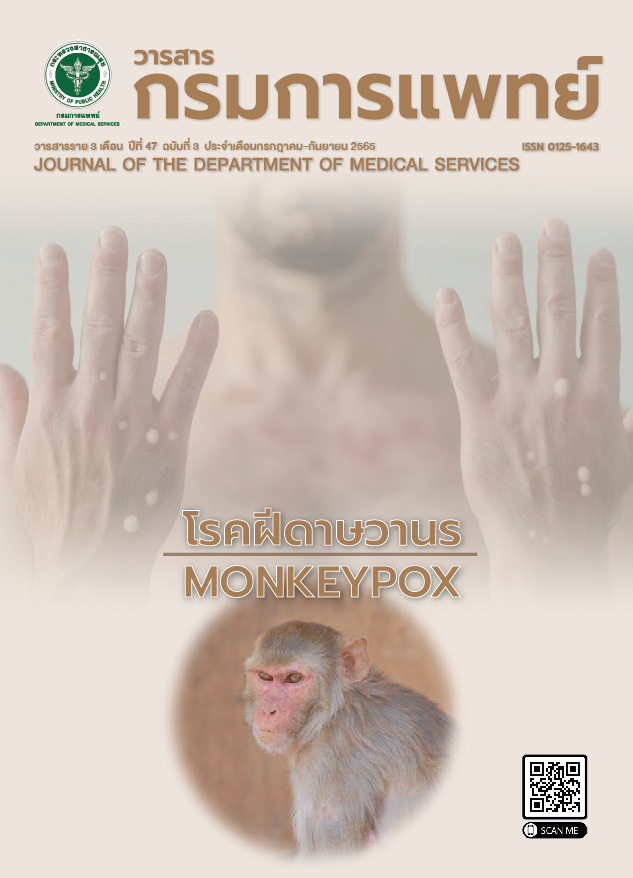Incidence and Factors Associated with Carbapenem-resistant Enterobacteriaceae and Vancomycin-resistant Enterococci in Rajavithi Hospital
Keywords:
Carbapenem-resistant Enterobacteriaceae, Vancomycin-resistant Enterococci, Rajavithi hospitalAbstract
Background: Drug-resistant bacterial infection of Carbapenem-resistant Enterobacteriaceae (CRE) and Vancomycin-resistant Enterococci (VRE) is a worldwide problem. The severity of this issue has been increasing, thus, it affects patients and healthcare staff both in hospitals and local communities. Objectives: To evaluate the incidence of CRE and VRE infection, and to study factors related to the occurrence of CRE and VRE. Methods: A retrospective cohort study research method was conducted in a sample group of 495 patients diagnosed with an infection of CRE or VRE in the fiscal year of 2019. The data analysis was done via descriptive statistics, poisson regression analysis, and identification of factors related to CRE and VRE occurrence. This study is ethically accepted by the Research Ethics Committee, Rajavithi Hospital. Results: This study found that among 495 patients of the sample group, 418 were infected with CRE-which were Hospital acquired infection (HAI), Community acquired infection (CAI), and colonization infections of 12, 28.8, and 10.4 events per 1,000 days of hospital stay respectively. The remaining 77 VRE-infected patients were categorized into HAI, CAI, and colonization infections of 2.1, 4.9, and 2.9 events per 1,000 days of hospital stay, respectively. The most common sites of CRE infection were the urinary tract (24.9%), the respiratory tract (22.7%), and the urinary tract with a retained urinary catheter (17.1%). As for VRE, the most common sites of infection were the urinary tract (41.9%), the urinary tract with a retained urinary catheter, ventilator-associated pneumonia, and skin infection - with the same percentage of 12.9. The most prevalent CRE species were Kleb. pneumoniae, E.coli, and E. cloacae, with the percentage of 70.7, 21.2, and 4.8, respectively. The most prevalent species of VRE, on the other hand, is E. faecium, being 100 percent in total. 51.3 percent of the patients are male, and 64 percent of the patients are 60 years old or older. Statistically significant factors related to drug-resistant bacterial infection (CRE and VRE) found in Rajavithi Hospital are patients whose first diagnosis before admission is Immunocompromise (RR 1.65; 95% CI: 1.09 to 2.50; p=0.019), and patients admitted in surgical ward (RR 1.58; 95% CI: 1.01 to 2.49; p=0.048). Conclusion: Incidence of CRE and VRE infection at Rajavithi Hospital is 12 and 2.1 times per 1,000 days of hospital stay, respectively. Factors such as sex, age, underlying diseases, severity of symptoms before admission, and discharge status, are not significantly different between CRE and VRE groups. However, associated factors that show statistically significant difference between these two groups are first diagnosis before admission and hospital wards. Thus, medical staff should have policies about continuous infection surveillance, prevention and control of the spreading of drug-resistant bacterial infection.
References
National Antimicrobial Resistance Surveillance Center Department of Science Ministry of Public Health, 2017.
Piwpong C. Incidence of Carbapenem-resistant Enterobacteriaceae in Suratthani Hospital. Reg 11 Med J 2016; 30: 1-12.
Nakonchai T. Factors Associated with Multi-Drug Resistant infections among Patients of Udonthani Cancer Hospital. Nursing, Health and Education Journal 2018; 1: 23-30.
Sadee P. The Prevalence of Carbapenem Resistant Enterobacteriaceae at Somdejphrachoataksinmaharaj Hospital, Tak. Journal of Bamrasnaradura Infections Disease Institute 2019; 13: 78-86.
Report of Laboratory examination result of Rajavithi Hospital. Clinical Microbiology Laboratory Records Program (MLAB), 2017-2018.
Sinlprakob O, Yindenai V. outbreak of Carbapenem-Resistant Enterobacteriaceae (CRE) in Neonatal Intensive Care Unit, Pathumthani Hospital. Journal of Prachomklao college of Nursing Phetchaburi Province 2019; 2.
Tribuddharat C. Molecular and Epidemiological studied of antibiotic-resistant bacteria using Next Generation Sequencing (NGS) techniques. Thai J. Genet. 2013; S: 46-51.
Sumpradit N, Suttajit S, Poonpolsub S, Chuanchuen R, Prakongsai P. Landscape of antimicrobial resistance situation and action in Thailand, Graphic and Design Publishing House, 2015.
Unahalekhaka A. Surveillance and outbreak Investigation of Hospital-Associated Infections, 2011.
Luvira V. Overview of antibiotic resistance. Songkla Med J 2006; 24: 453-459.
Phumisantiphong U. Incidence of Carbapenem Resistant Enterobacteriaceae. Vajira Medical Journal 2011; 55.
Phumart P, Thamlikitkul V, Prakongsai P, Photha T, Riewpaiboon A, Limwatananon S. Health and Economic Impacts of Antimicrobial Resistant Infections in Thailand: A Preliminary Study. Journal of Health Systems Research 2012; 6.
Phutthanachote N, Suggaravetsiri P, Srisai C. Factors Associated with carbapenem- resistant Pseudomonas aeruginosa strain infections among patients at Roi Et Hospital, Thailand. J Med Tech Phy Ther. 2017; 29.
Uppanisakorn S, Tinnikom K, Boonyarat J. The outcome of control the bacteria multidrug-resistant in medical ICU, tertiary hospital. Reg 11 Med J 2017; 31: 649-656.
Dangpheng Y, Jareonkul K. Prevalence of Carbapenem-Resistant Enterobacteriaceae Infection Among Patients Attending in Tertiary Care Hospital, Bordering Province of Southern Thailand. Journal of Health Science Thaksin University 2019; 1.
Kanjanayotin A. Effect of Implementing an Action Plan Based on AIC Technique on Practices of Nursing Personnel for Prevention of Catheter-associated Urinary Tract Infection. Master of Nursing Thesis graduate school Chiang Mai University, 2008.
Tongrod W. Academic Article: Antimicrobial resistance. Center for Continuing Pharmaceutical Education, 2018.
Eagye KJ, Kuti JL, Nicolau DP. Risk factors and outcomes associated with isolation of meropenem high-level-resistant Pseudomonas aeruginosa. Infect Control Hosp Epidemiol 2009; 30: 746-52.
Guh AY, Bulens SN, Mu Y, Jacob JT, Reno J, Scott J, et al. Epidemiology of Carbapenem-Resistant Enterobacteriaceae in 7 US communities, 2012-2013. JAMA 2015; 314: 1479-87.
Downloads
Published
How to Cite
Issue
Section
License
Copyright (c) 2022 Department of Medical Services, Ministry of Public Health

This work is licensed under a Creative Commons Attribution-NonCommercial-NoDerivatives 4.0 International License.
บทความที่ได้รับการตีพิมพ์เป็นลิขสิทธิ์ของกรมการแพทย์ กระทรวงสาธารณสุข
ข้อความและข้อคิดเห็นต่างๆ เป็นของผู้เขียนบทความ ไม่ใช่ความเห็นของกองบรรณาธิการหรือของวารสารกรมการแพทย์



